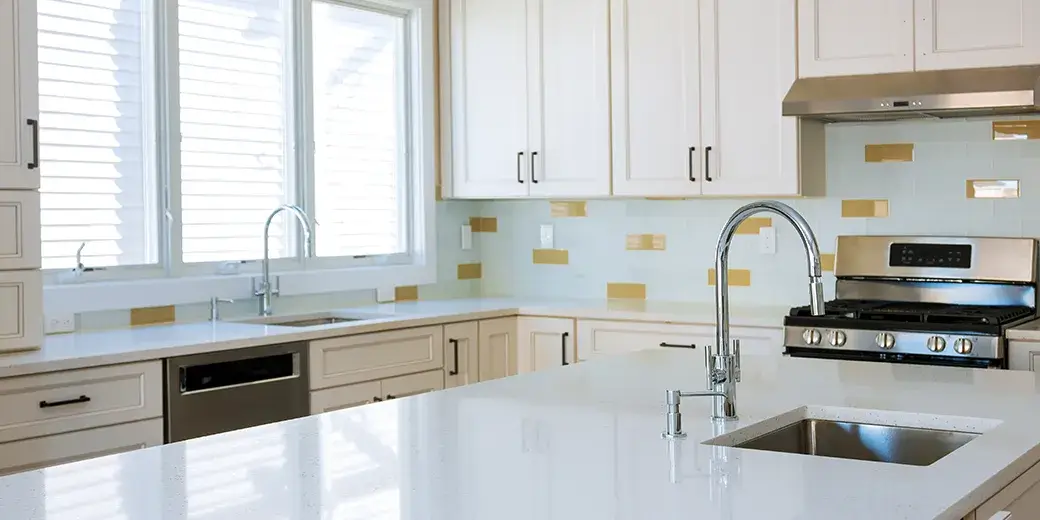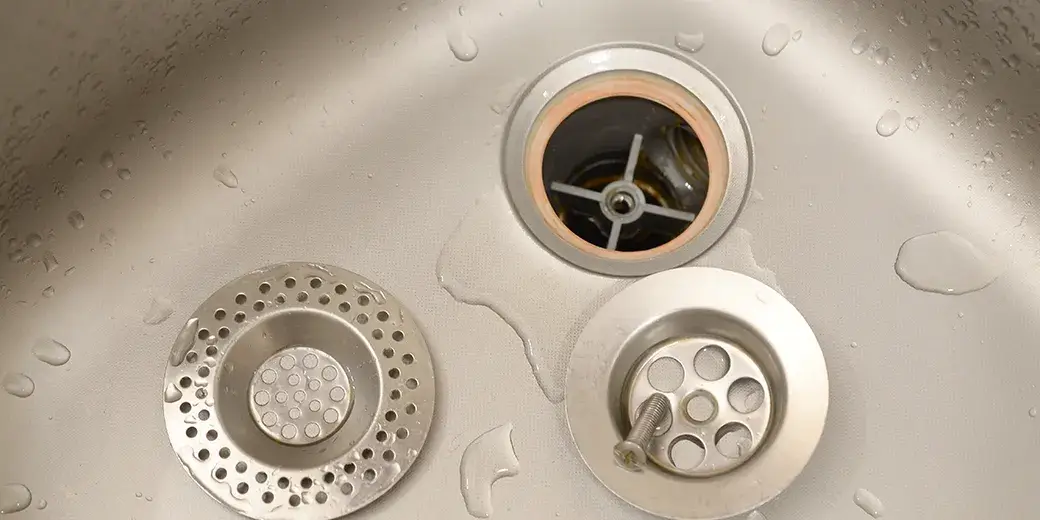Understanding the Common Causes of Clogged Kitchen Sinks
I. Introduction:
A functional kitchen sink is the cornerstone of any well-operating kitchen. It’s the place where we wash dishes, prepare meals, and tidy up after a long day of cooking and cleaning. Yet, despite its central role, we often take our kitchen sinks for granted until something goes wrong. And nothing can disrupt the flow of your culinary oasis quite like a clogged sink.
Clogged kitchen sinks are not just an inconvenience; they can be a source of frustration and even financial strain if not addressed promptly. But before you find yourself in this predicament, it’s essential to understand the common causes of these blockages, as prevention is often the most straightforward and cost-effective solution.
In this blog post, we’ll dive deep into the intricacies of clogged kitchen sinks. We’ll explore the various factors that contribute to this household nuisance, shedding light on everything from food residues to outdated plumbing. By the end of this journey, you’ll be armed with the knowledge to keep your kitchen sink flowing freely and your culinary haven in tip-top shape. So, let’s roll up our sleeves and delve into the heart of the matter: understanding the common causes of clogged kitchen sinks.
II. Accumulation of Food Residues
The accumulation of food residues is a common cause of clogged kitchen sinks and occurs when small bits of food or food particles go down the drain and become trapped in the plumbing pipes. This build-up of food debris can lead to blockages, slow drainage, and, in severe cases, complete sink backups.
Here’s a more detailed explanation of the accumulation of food residues:
- How Food Particles Enter the Drain: When we wash dishes or rinse food off plates, pots, and utensils in the sink, tiny food particles often get carried away with the water. While it may seem harmless initially, over time, these particles can accumulate within the pipes.
- Role of Grease and Oil: Fats, oils, and greases from cooking can further exacerbate the problem. When these substances are washed down the sink, they can solidify and cling to the inner walls of the pipes. This creates a sticky surface that easily traps food particles passing through.
- Progressive Build-Up: As more food particles and grease accumulate, they can start to create obstructions in the pipes. This build-up narrows the passage for water, making it difficult for it to flow freely. Additionally, as these food particles decompose, they can produce unpleasant odors, making your sink less pleasant to use.
- Consequences of Food Residue Accumulation: Over time, this accumulation can result in slow drainage and, eventually, a fully clogged sink. It may also lead to more serious plumbing issues, such as pipe corrosion, which can be costly to repair.
Preventative Measures: To prevent the accumulation of food residues and maintain a clog-free kitchen sink, consider taking the following preventative measures:
- Use Sink Strainers: Install sink strainers or drain screens to catch food particles before they go down the drain.
- Scrape Plates: Before washing dishes, scrape leftover food into the trash or compost to reduce the amount of food going down the drain.
- Dispose of Cooking Grease Properly: Instead of pouring hot grease or oil down the sink, allow it to cool and solidify in a container, then discard it in the trash.
- Regular Cleaning: Periodically clean your sink with a mixture of baking soda and vinegar to break down any accumulated residue.
Understanding the role of food residue accumulation in clogged kitchen sinks is the first step toward prevention. By adopting good practices and proper maintenance, you can keep your kitchen sink functioning smoothly and avoid the inconveniences associated with clogs.
III. Foreign Objects and Debris
- Common Foreign Objects: Foreign objects can include a wide range of items that are not meant to be disposed of in the sink. Common examples include silverware (such as forks or spoons), bottle caps, jewelry, and small kitchen tools. These items can accidentally fall into the sink while washing dishes or food preparation.
- Debris: Debris refers to any non-food particles that might find their way into the sink. This can include things like coffee grounds, tea leaves, small bits of paper, or even cleaning supplies that were not properly disposed of.
- Impact on Drainage: When foreign objects or debris enter the plumbing system, they can create blockages or obstructions. These blockages restrict the flow of water and can cause backups in your sink. In severe cases, these blockages can even lead to damage in the plumbing system.
- Sink Garbage Disposal: In some cases, foreign objects and debris can enter the garbage disposal unit, which is a common feature in many kitchen sinks. While garbage disposals are designed to grind down food particles, they are not intended to handle non-food items. Attempting to grind or dispose of foreign objects in the garbage disposal can lead to clogs, damage to the disposal unit, or even the need for repairs.
- Preventative Measures: To prevent clogs caused by foreign objects and debris, it’s essential to be mindful of what goes down the sink. Here are some preventive measures:
- Use a sink strainer or drain screen to catch foreign objects and debris.
- Be cautious when washing dishes, ensuring that small items like silverware are securely placed away from the drain.
- Dispose of non-food items and debris in the appropriate waste receptacle.
IV. Soap and Mineral Buildup
Soap and mineral buildup in kitchen sinks are common causes of clogs that occur gradually over time. These buildups can restrict the flow of water and eventually lead to slow drainage and even complete blockages. Here’s a detailed explanation of soap and mineral buildup in kitchen sinks:
- Soap Scum Buildup:
- How It Forms: Soap scum is a white, chalky residue that results from the reaction between soap and hard water minerals like calcium and magnesium. When soap combines with these minerals, it forms a solid substance that adheres to the sink, faucet, and drain surfaces over time.
- Contribution to Clogs: As soap scum accumulates, it can coat the walls of the plumbing pipes, reducing the effective diameter and making it more challenging for water to pass through. This can lead to slow drainage and eventual blockages.
- Mineral Buildup (Scale):
- How It Forms: In areas with hard water, mineral buildup, often referred to as “scale,” can occur. Hard water contains a high concentration of minerals, and when this water evaporates on sink surfaces, it leaves behind deposits of calcium and magnesium carbonate.
- Contribution to Clogs: These mineral deposits can accumulate within the pipes and fixtures, narrowing the passage for water to flow through. Over time, the accumulation can impede water flow and lead to clogs.
- Consequences:
- Slow Drainage: Soap and mineral buildup gradually constrict the pipe’s diameter, resulting in slower drainage from the sink. This can be frustrating and less efficient for everyday kitchen tasks.
- Odor Issues: The organic matter in soap scum can decompose, leading to unpleasant odors in your sink and drains.
- Preventative Measures:
- Regular Cleaning: Regularly clean the sink, faucet, and drain using a mixture of baking soda and vinegar or commercial descaling products to remove soap scum and mineral deposits.
- Install a Water Softener: In areas with hard water, consider installing a water softener to reduce the mineral content in your tap water.
- Use Soap Wisely: Use liquid soap instead of bar soap, as it tends to produce less soap scum. Using soap sparingly can also help reduce buildup.
Understanding the role of soap and mineral buildup in clogged kitchen sinks emphasizes the importance of maintenance and water quality. By taking steps to prevent or address these issues, you can keep your sink functioning efficiently and prevent the inconveniences of slow drainage or sink backups.
V. Outdated or Damaged Plumbing
Outdated or damaged plumbing is a less common but still significant cause of clogged kitchen sinks. When the plumbing system in your kitchen is outdated or in a state of disrepair, it can lead to a range of issues, including clogs. Here’s a detailed explanation of how outdated or damaged plumbing can contribute to clogged kitchen sinks:
- Outdated Plumbing:
- Explanation: Outdated plumbing refers to plumbing systems that may be old and no longer meet modern standards or requirements. These systems might have pipes made from materials that are prone to corrosion or deterioration, such as galvanized steel or iron.
- Contributions to Clogs: Over time, old pipes can develop rust, corrosion, and weak spots. These issues can result in the formation of rough, uneven surfaces inside the pipes that can trap debris, causing clogs.
- Damaged Plumbing:
- Explanation: Damaged plumbing includes pipes that have cracks, leaks, or other structural issues. These problems may occur due to age, physical damage, or other factors.
- Contributions to Clogs: Cracked or damaged pipes can allow soil, debris, and roots to infiltrate the plumbing system. These intrusions can obstruct the flow of water, leading to clogs.
- Signs of Outdated or Damaged Plumbing:
- Water Discoloration: If you notice discolored water, particularly if it’s rusty or brown, it may be a sign of corroded pipes.
- Leaks: Visible leaks or persistent dripping from your pipes are clear indicators of plumbing issues.
- Frequent Clogs: If your sink experiences frequent or persistent clogs despite best efforts to maintain it, it might be due to damaged or outdated plumbing.
- Consequences:
- Frequent Clogs: Outdated or damaged plumbing is more susceptible to clogs, resulting in a higher frequency of sink blockages.
- Water Damage: Leaky or damaged pipes can lead to water damage to your home’s structure, potentially resulting in costly repairs.
- Addressing Outdated or Damaged Plumbing:
- Professional Inspection: Consult a professional plumber to assess your plumbing system and identify any issues. They can recommend necessary repairs or replacements.
- Replacement: In some cases, it might be necessary to replace outdated or severely damaged plumbing with newer, more durable materials.
Understanding the role of outdated or damaged plumbing in clogged kitchen sinks underscores the importance of regular maintenance and, when needed, upgrading your plumbing system. By addressing these issues promptly, you can prevent recurring clogs and maintain the proper functioning of your kitchen sink.
VI. Overuse of Garbage Disposals
The overuse of garbage disposals is a common cause of clogged kitchen sinks, and it occurs when the disposal unit is used improperly or excessively. Garbage disposals are designed to grind down food waste, making it easier to flush down the drain. However, when they are overused or used for the wrong types of materials, it can lead to clogs and other plumbing issues. Here’s a detailed explanation of the overuse of garbage disposals:
- Role of Garbage Disposals:
- How They Work: Garbage disposals consist of a grinding mechanism that shreds food waste into small particles. These particles can then flow more easily through the plumbing system.
- Common Usage: Garbage disposals are typically used for disposing of food scraps, such as vegetable peels, fruit rinds, and small bits of leftover food.
- Overuse or Improper Use:
- Grinding Non-Food Items: One of the most common mistakes is grinding non-food items, such as plastics, glass, or metal, in the disposal. These items can damage the disposal’s blades and lead to clogs.
- Excessive Food Waste: Another issue is using the disposal for excessive amounts of food waste at once. Overloading the disposal can strain the motor and make it less effective in grinding down the waste.
- Contributions to Clogs:
- Ineffective Grinding: Overused or damaged disposals may not grind food waste effectively, leaving larger food particles that can lead to clogs.
- Residue Buildup: Despite grinding, some residue may still cling to the pipes, creating a conducive environment for clogs to develop.
- Consequences:
- Clogs: Overuse of garbage disposals can result in clogs in the sink’s plumbing system, leading to slow drainage or backups.
- Disposal Damage: Grinding non-food items or overloading the disposal can cause damage to the unit, necessitating repairs or replacement.
- Best Practices for Using Garbage Disposals:
- Use Cold Water: Always run cold water while using the disposal. This helps in flushing the ground waste down the drain.
- Avoid Non-Food Items: Never put non-food items in the disposal. Be cautious about bones, large fruit pits, or extremely hard food waste.
- Moderation: Use the disposal in moderation and avoid overloading it with a large quantity of food waste.
Understanding the impact of overuse of garbage disposals on clogged kitchen sinks emphasizes the importance of responsible use and regular maintenance. By following best practices and being mindful of what goes into the disposal, you can prevent clogs and maintain efficient sink drainage.
VII. Conclusion
In conclusion, a clogged kitchen sink can quickly disrupt the functionality of one of the most important areas of your home. However, by delving into the common causes of clogs and the preventive measures discussed in this blog post, you can equip yourself with the knowledge and strategies needed to keep your kitchen sink flowing freely.
From tackling food residues and foreign objects to addressing soap and mineral buildup, taking these steps can help you avoid the inconveniences and expenses associated with sink clogs. Moreover, by maintaining your plumbing system and using your garbage disposal wisely, you can ensure that your kitchen sink remains the efficient and clean workspace you rely on for everyday culinary adventures.
So, let’s take these tips and fixes to heart, keep our sinks running smoothly, and bid farewell to clogs and their accompanying headaches. Your kitchen will thank you, and so will your wallet.
Want a Free Quote?
Contact us today to discuss your needs and get an accurate estimate at no obligation. Planning made easy.
Want a Free Quote?
Contact us today to discuss your needs and get an accurate estimate at no obligation. Planning made easy.
Contact us:



